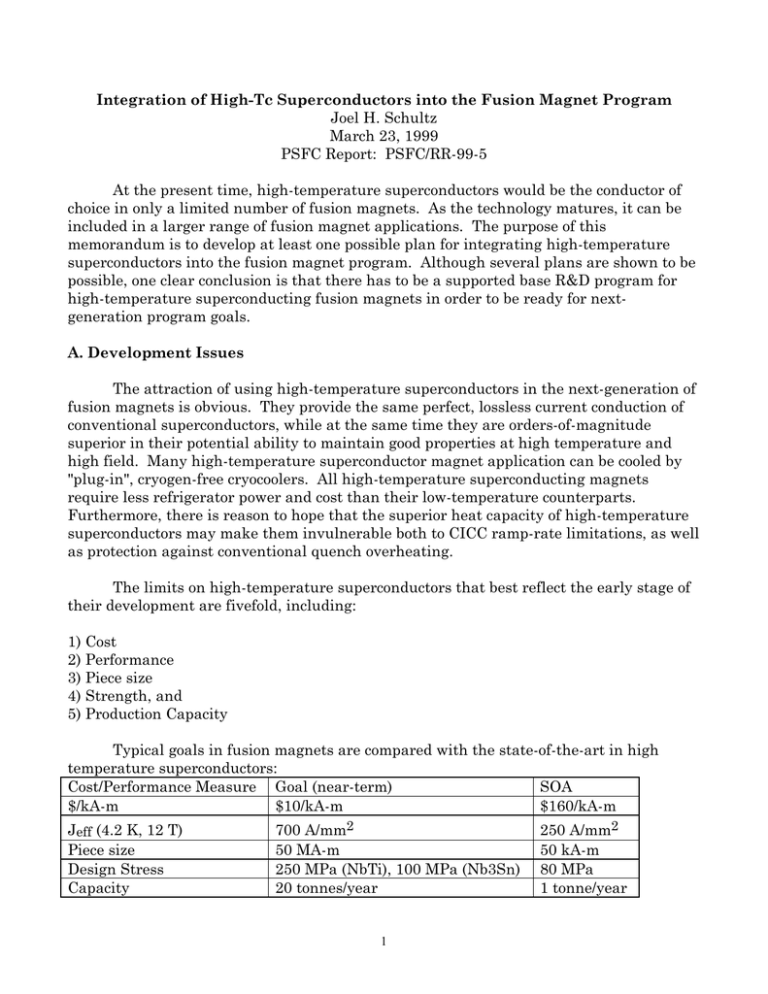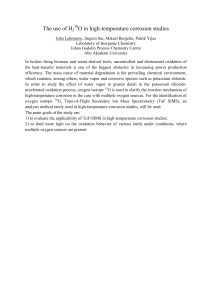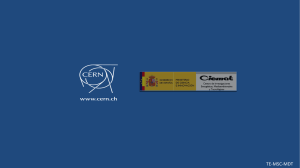Integration of High-Tc Superconductors into the Fusion Magnet Program
advertisement

Integration of High-Tc Superconductors into the Fusion Magnet Program Joel H. Schultz March 23, 1999 PSFC Report: PSFC/RR-99-5 At the present time, high-temperature superconductors would be the conductor of choice in only a limited number of fusion magnets. As the technology matures, it can be included in a larger range of fusion magnet applications. The purpose of this memorandum is to develop at least one possible plan for integrating high-temperature superconductors into the fusion magnet program. Although several plans are shown to be possible, one clear conclusion is that there has to be a supported base R&D program for high-temperature superconducting fusion magnets in order to be ready for nextgeneration program goals. A. Development Issues The attraction of using high-temperature superconductors in the next-generation of fusion magnets is obvious. They provide the same perfect, lossless current conduction of conventional superconductors, while at the same time they are orders-of-magnitude superior in their potential ability to maintain good properties at high temperature and high field. Many high-temperature superconductor magnet application can be cooled by "plug-in", cryogen-free cryocoolers. All high-temperature superconducting magnets require less refrigerator power and cost than their low-temperature counterparts. Furthermore, there is reason to hope that the superior heat capacity of high-temperature superconductors may make them invulnerable both to CICC ramp-rate limitations, as well as protection against conventional quench overheating. The limits on high-temperature superconductors that best reflect the early stage of their development are fivefold, including: 1) Cost 2) Performance 3) Piece size 4) Strength, and 5) Production Capacity Typical goals in fusion magnets are compared with the state-of-the-art in high temperature superconductors: Cost/Performance Measure Goal (near-term) SOA $/kA-m $10/kA-m $160/kA-m Jeff (4.2 K, 12 T) Piece size Design Stress Capacity 700 A/mm2 50 MA-m 250 MPa (NbTi), 100 MPa (Nb3Sn) 20 tonnes/year 1 250 A/mm2 50 kA-m 80 MPa 1 tonne/year Clearly, high-temperature superconductors are not yet a sufficiently established industry to provide conductor for the most demanding applications (e.g. 1,000 tonnes of superconductor for ITER). However, they are not as far away as the above table suggests. Cabling of strands or wrapping tapes about a core can increase the effective amperemeters of an unjointed conductor by orders of magnitude, as demonstrated recently by the American Superconductor Corporation and Pirelli, who developed a 2,500 A high-voltage transmission line cable, by wrapping multiple tapes about a cylindrical coolant line. This approach had too low an overall current density for a fusion magnet and one central purpose of a fusion conductor/magnet development program would be to develop conductor concepts with an adequate combination of current density, field, and cost at reasonably elevated temperature. B. Application Strategy All five of today's limits point toward a strategy of beginning with the simplest magnets: those that are small and have low field and current density. This buys time and gains experience at the smallest cost to the fusion program. The plan developed here proposes three stages, progressing to medium performance/size magnets, and ending with the high performance/large size magnets needed for a successful fusion program. Magnet programs that fit this strategy the best are listed in Table I, II, and III. Table I: Magnets/Conductors that are "Small and Near-Term" Project/Magnet Approval Year Icond Jwp Bmax kA-m (kA) (A/mm2) (T) (kA-m) 1998 LDX L-Coil F-Coil Electra 1998 Helmholtz NCSX 2001 Saddle Coils TF Coils 3.2 2.13 6.4 99 1 5.1 @ 11 T 643 3,620 1.1 3.7 0.3 1,800 7 7 70 1 (2 upgrade) 14,600 70 2 79,640 The LDX F-Coil is of particular interest because the coil warms up from 5 K to its currentsharing temperature, while the coil is magnetically suspended in a vacuum tank. A hightemperature superconductor should be able to greatly extend the operating time of the experiment. However, the F-coil is somewhat too ambitious for immediately implementation, and should be funded by the Office of Fusion Energy after the success of an L-coil demonstration. The Levitating L-Coil and the Electra Helmholtz coils are within the range of an immediate, low-cost implementation. 2 Table II: Medium-Sized Magnet Systems Project/Magnet Approval Year Icond Jwp Bmax (kA) (T) (A/mm2) kA-m (kA-m) 1998 KSTAR TF CS PF FEC 35.2 26.4 17.2 3.2 47 41.8 30.1 32 7.4 8.0 3.0 1.9 346,678 169,500 126,076 10,108 CS PF PF1-3 73.7 64.9 57 44 46.6 38 20 7 7 211,567 445,150 263,514 PF1-9 PF10,11,16,17 PF12-15 50? 50? 50? 113 102 45.3 29.8 11.6 6.3 87,083 144,604 134,192 2003? FIRE Ignitor Project/Magnet Table III: Large-Scale Magnet System Approval Year Icon Jwp Bma d kA-m x (kA) (A/mm2) 60.2 38 60 7.5 26.6 15.8 11.2 2.8 (T) (kA-m) 12.8 13 7 5 10,171,000 1,814,000 6,965,000 89,000 ?2025 ITER TF CS PF FEC 2001 ITER-RC TF CS 57.8 18.8 12.4 5,500,000 1,299,000 2.2 60 5.5 6 2,438,000 2-10,000,000 PF IRE 2004 C. Recommendations: The two most obvious candidates for short-term demonstration of high-temperature superconducting magnets are the LDX L-Coil and the Electra Helmholtz Coil. These have the following advantages: 3 1) The applications are modest and would only require a few per cent of last year's global output of high temperature superconductor. They are also both small enough to be funded from a Phase II SBIR. 2) Both magnet demonstrations are welcomed by the management of the LDX and Electra projects, respectively. Both programs are highly sensitive to the requirement for hightemperature superconductor magnets in their respective nuclear reactor designs. 3) In neither case would the coils be on the critical path of a physics program, but would be implemented as upgrades. In the case of LDX, in particular, the power and water requirements for the normal copper L-Coil are the dominant loads in the facility. If the LCoil were superconducting, it would be possible to apply much more pulsed auxiliary power to the plasma. The identification of the best medium-term application(s) is more difficult. The basic philosophy should be to scale up by another order of magnitude, so that the conductor requirement would be consistent with capacity, 1-2 years from now. Applications in the range of 10,000 to 100,000 kA-m would be in the range of 10-100 % of last year's global tape production. Cost goals of $50-100/kA-m would put the conductor costs of these applications in the range of $0.5-10 M. The overall current density requirement should also be increased from 5-10 A/mm2 to at least 20-40 A/mm2 at 2-5 T in order to achieve the performance goals of a large range of fusion magnets. C.i NCSX: Saddle Magnet Option If NCSX proceeds to select the saddle-coil option, high-temperature superconductors would probably be a very good choice, especially if the conductor purchase is delayed by a year or so, so that the conductor cost could be held to < $1 M. The reason that hightemperature superconductors would be favored include the following: 1) Water-cooled conductors were infeasible, because they weren't able to achieve the overall current density of 70 A/mm2. 2) Inertial-nitrogen-cooled normal conductors are currently favored, because they can achieve the needed current density. However, they also induce eddy currents in surrounding structure that might ruin the sophisticated field line trajectories of the NCSX design. 3) The use of finished SSC cable is nearly ideal, because it is free and has higher current density at low field than any of the alternatives. However, there are concerns that pulsing of the PBX-M TF coils might quench the low-temperature conductor. Here, although the high-temperature superconductor could not compete directly in cost, it probably would be the best choice, because of its absence of feasibility problems. Since the conductor is laid in grooves, Lorentz loads can be transmitted through insulation and shims to a structural shell without a need to coprocess the reinforcement. 4 C.ii KSTAR FEC Coils The KSTAR FEC coils are another good choice for the early application of hightemperature superconductors. The A-m and field requirements are similar to those of NCSX, while the overall current density is smaller. It is too late for high-temperature superconductors to be used in the TF coils, since the first production order for Nb3Sn has been placed. However, the NbTi for the FEC coils is not on the machine critical path, and the conductor order will probably not be placed for two years. The use of hightemperature superconductors would have the following advantages. 1) Since the FEC coils are mounted on the KSTAR TF coil cases, there is an excellent chance that further cost reductions and simplification of internal plumbing could be achieved by indirect cooling, perhaps even by the cold structure itself without additional cryocoolers. 2) Since the coils have low stored energy and 12 independent power supplies, the Korea Basic Science Institute would probably be happy with further reduction of conductor current and power supply size. 3) The use of high-temperature superconductors in a DC current, modest pulsed-field environment is expected to be easier to qualify against field ramp-rate limitations than a NbTi CICC conductor. The disadvantages of the KSTAR FEC coils include the following: 1) The US fusion program won't learn as much about HTSC applications by participating in KSTAR. Test data and operations will not be routinely documented in English. 2) The KSTAR management is conservative with respect to design changes and may not welcome the introduction of HTSC as a technology-development goal. 3) KSTAR is conceived as a method for developing Korean industry. Any component that can be provided by Korean industry is bid noncompetitively. We don't know whether any Korean industry can produce high-temperature superconductors; but if they can, US companies won't be allowed to compete. C.iii LDX F-Coil The F-coil in the Levitated Dipole Experiment could float for a significantly longer time, if it used high-temperature superconductors. Since the beginning of the LDX program, it has been planned to build an original F-coil and then to replace it with a higherperformance, higher float-time upgrade. The use of high-temperature superconductors in an internally-cooled F-coil is also an intrinsic part of the Levitated Dipole reactor concept. The advantages of using high-temperature superconductors in an F-Coil upgrade include the following: 5 1) Allowing the F-coil to operate from 5 K to 30 K, instead of 5 K to 10 K, increases the thermal capacity of the coil by two orders of magnitude. At 30 K, the heat capacity of the solids is as significant as that of the helium. 2) The LDX management is technically progressive and would welcome the use of hightemperature superconductors with enthusiasm, if the operating time could be substantially increased without decreasing field or flux expansion. 3) The successful levitation of a large cryostat for over a day might be newsworthy and generate favorable publicity for the fusion program and HTSC. The disadvantages include: 1) The current density and stress levels in the F-coil are considerably higher than those in the previously-recommended magnet systems. HTSC tapes may not be ready in 2-3 years. 2) The protection method used for the F-coils of passive quench propagation probably won't work for HTSC. Floating coils cannot be dumped externally and a new quench method will have to be developed. A return to previously considered topologies, including interleaved aluminum sheets and an iron outrigger would have to be considered. The disadvantages, particularly 1) can also be considered to be advantages in that they would force the stress-management and current density-management capabilities of HTSC magnets to improve by an order of magnitude. C.iv FIRE and IGNITOR FIRE and IGNITOR might be able to use high-temperature superconductors in the outer PF coils. These would have the benefits of lowering the overall power and energy requirements of those experiments. Since the use of HTSC in FIRE and IGNITOR is more ambitious than its uses in NECX, KSTAR, or LDX by an order-of-magnitude, it would also bring HTSC a "generation" closer to its ultimate use in large fusion reactors. Advantages of the use of HTSC conductor in FIRE and IGNITOR include the following: 1) A truly intermediate-size step is needed for HTSC in the next decade, if it is to be viable technology for use in any large-scale projects in the next two decades. There would have to be at least one demonstration project, using $10-20 M of HTSC, if we are to contemplate their use in magnet systems requiring $100-200 M. 2) IGNITOR and FIRE are both normal magnet systems with substantial energy dissipation. Any reduction of that dissipation could pay for itself by reducing the need for on-site energy storage. Also, since both systems require cryogenic cooling to 30-80 K, there is no refrigeration penalty in the use of high-temperature superconductors. 6 Disadvantages of the use of HTSC conductor in FIRE and IGNITOR include the following: 1) Both projects attempt to create low-cost, compact plasma burn or ignition experiments by eliminating expensive components (read: "superconducting magnets") and operating at high working stresses. FIRE management would not permit the use of high-temperature superconducting magnets, unless they could be justified on a first-cost basis (i.e. without claiming savings in operating costs). IGNITOR has inquired about the use of HTSC and would probably be built in Italy, where electricity is more expensive. However, it is unlikely to use HTSC as a part of a longer-term technology development goal. 2) The working stresses in IGNITOR are very high. PF12-14 have JBR products of 236352 MPa, while PF15 has a JBR product of 595 MPa. All other PF coils have peak flux densities of 11-30 T. At temperatures of 30-80 K, these will have to await the development of practical YBCO conductors. 3) Only a small fraction of the FIRE or IGNITOR coils could be made with HTSC in the next decade. The benefits to the cost of stored energy and power supplies might justify the use of HTSC on a lifetime-cost basis. However, the total cost of coils and power supplies could only be improved by a small amount. The overall magnet mission, defined in terms of field on axis, plasma current, and volt-seconds would be completely unaffected. C. Recommendations Since US industry has plans to introduce high-temperature superconductors in a broad range of products over the next decade, it seems reasonable that the US fusion program should plan to introduce high-temperature superconductors over a broad range of fusion magnets in the next two decades. The main obstacle to this goal is the development of adequate current-piece lengths and overall capacity. A review of present-day conductor status and projections in the high-temperature superconductor industry, along with the "portfolio" of possible fusion projects in the next decade leads to the following conclusions: 1) 2) 3) High-temperature superconductors should be introduced in three phases: small (100-2,000 kA-m), medium (4,000-100,000 kA-m), and large (500,000-20 M kA-m), usually corresponding to short-term, medium-term, and long-term projects. Two excellent small-scale magnets have been identified: the LDX L-coil and the Electra Helmholtz coils. These are compatible with SBIR Phase II funding levels. A number of good medium-scale magnets have been identified. It should be noted that since these are medium-term projects, the sizing is based on current knowledge of design status. More design work would have to be done to finalize an evaluation. The medium-size magnet systems are ranked in the following order: 1) 7 4) 5) 6) 7) NCSX Saddle Coils, 2) LDX F-Coil, 3) KSTAR FEC Coils, 4) IGNITOR PF coils, and 5) FIRE PF coils The KSTAR, IGNITOR, and FIRE coils are a stretch. They probably can't be approved unless the US fusion program makes a conscious decision to develop fusion magnet systems using high-temperature superconductors and off-loads some of the direct costs from the projects. Unless something on the scale of the PF coils for a burning-plasma experiment is built, it is improbable that HTSC will be ready in the next two decades for use in large-scale fusion experiments. Without a 200,000-400,000 kA-m demonstration, we would be asking for 2-3 orders of magnitude scaleup. To the best of our knowledge, there are no industrial applications of HTSC with the high current (50 kA) and high energy (10 GJ) requirements of FIRE and IGNITOR, so it is unlikely that HTSC will become adequately developed in the next decade through commercial application alone.. Each scaleup in current and current-density should probably be preceded by shortsample conductor testing. Separate conductor tests at a level of 5 kA and 50 kA, removed from machine critical paths but related to upcoming projects, should be conducted over the next decade. Ramp-rate and ramp-loss measurements on subscale conductors should also be done. Extrapolations to large-scale applications are almost impossible at this time, both because of the great uncertainties in the fusion program and the orders-ofmagnitude extrapolations needed for the high-temperature superconductors. While it would be highly desirable to adopt a "one-step-to-pre-DEMO" strategy, it is too much of an extrapolation. If the first two steps of HTSC introduction are completed successfully, it should then be possible to reassess and develop a logical plan for developing HTSC conductors for large-scale, high-performance fusion applications. 8

